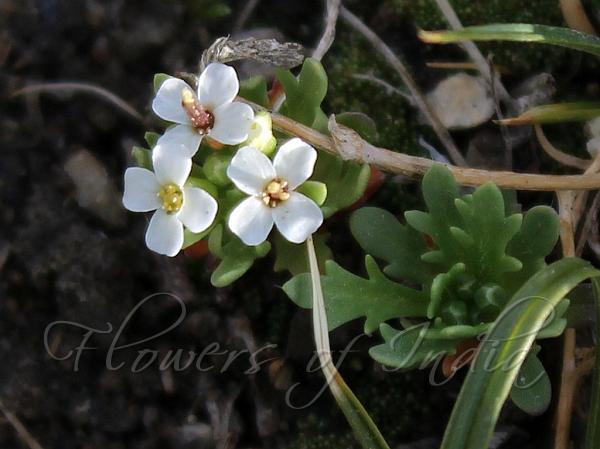|
| Himalayan Peppergrass |
|

|

| File size | 174330 |
| Original date | 6/21/16 7:00 AM |
| Resolution | 1024 x 768 |
| Flash | Flash did not fire, auto |
| Focal length | 55.0mm |
| Exposure time | 1/250s |
| Aperture | 5.6 |
| Focus Distance | |
| Metering Mode | Spot |
| Camera make | Canon |
| Camera model | Canon EOS 700D |
| Sensor type |
|
|
|
|
Photo: |
Botanical name: Lepidium capitatum Family: Brassicaceae (Mustard family)
Synonyms: Lepidium incisum Edgew., Lepidium kunlunshanicum G.L. Zhou & Z.X. An
Synonyms: Lepidium incisum Edgew., Lepidium kunlunshanicum G.L. Zhou & Z.X. An
Himalayan Peppergrass is an annual or biennial
herb, up to 20-25 cm long, rising up or nearly erect, branched, often
spreading, glandular hairy. Lower leaves are pinnately cut, 3-6 cm
long, 1-2 cm broad, narrowed into a short stalk or stalkless, with
narrow oblong pointed lobes. Upper leaves are pinnately cut or simply
toothed, stalkless, smaller, usually not much different from the lower
ones. Flowers are borne in 20-30 flowered, dense, congested or
head-like racemes, without bracts, hardly increasing up to 3 cm in
fruit. Flowers are white, very small - petals white, obovate, 1.8-2.5 x
1-1.3 mm, tip rounded. Flower-stalks are up to 4 mm long in fruit,
thread-like, spreading. Stamens are 4 (outer 2 absent), with minute
anthers. Seed-pods are 2.5-3 mm long, about 2.5 mm broad, ovate,
slightly notched at the tip with nearly stalkless stigma not exceeding
the notch, hairless, obscurely winged at the tip. Himalayan Peppergrass
is endemic to the Himalayas, from Kashmir, Ladakh to Tibet and Nepal,
at altitudes of 3600-5300 m. It is common in Ladakh. Flowering:
May-June.
Medicinal uses: It is believed to be useful in
making post-coital contraceptive.
It is believed to be useful in
making post-coital contraceptive.
Medicinal uses:
 It is believed to be useful in
making post-coital contraceptive.
It is believed to be useful in
making post-coital contraceptive. | Identification credit: Hussain Barbhuiya, Miroslav Dvorský | Photographed near Pangong Lake, Ladakh. |
• Is this flower misidentified? If yes,